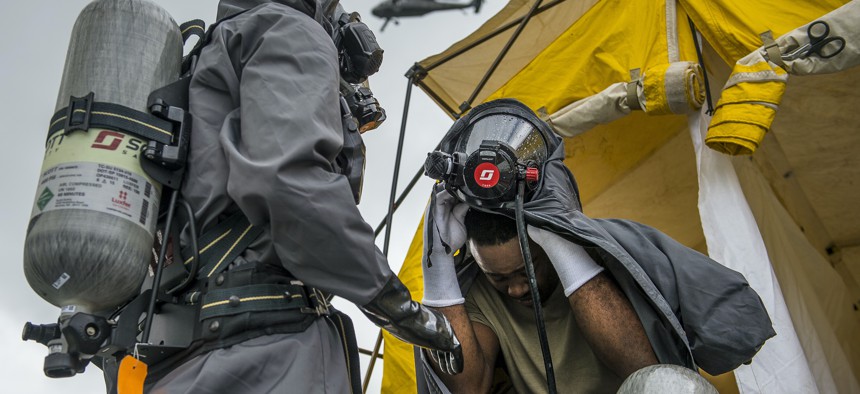
Pfc. Khalid Harrison, a U.S. Army soldier with the 51st Chemical Biological Radiological Nuclear Company, of Fort Stewart, Georgia, removes his chemical suit for decontamination during a training exercise at the Muscatatuck Urban Training Center, Indiana, April 27, 2017. U.S. Army / Master Sgt. Michel Sauret
As Clouds Gather in Eastern Europe, Nuclear Diplomacy is More Important Than Ever
More must be done to keep tensions over Ukraine from deepening nuclear instability.
The risk that a Russian invasion of Ukraine by conventional forces could lead to the use of nuclear weapons appears relatively low, but their shadow is never completely absent from a crisis involving nuclear-armed states. Moreover, this crisis—no matter how it ends—seems likely to lead toward more strategic instability, not less. As preoccupied as U.S. diplomats must be with the threat of imminent conventional invasion, they must also work urgently to launch confidence-building measures that might prevent a nuclear war.
The recent back-and-forth between Washington and Moscow has been free of explicit nuclear threats, but there has been some nuclear signaling. As Russia massed forces near Ukraine in December, its foreign ministry released two proposed treaties, one for NATO and one for the United States. The draft of the NATO treaty included an article prohibiting the deployment of missiles previously outlawed by the Intermediate-range Nuclear Forces Treaty. The draft of the U.S. treaty had more explicit references to nuclear weapons, including pledges to not deploy them outside national territory and to not train personnel from non-nuclear countries in their use—a reference to NATO nuclear-sharing arrangements.
Washington’s response to the buildup has centered on sanctions and deploying conventional military forces to NATO allies in eastern Europe. But it has also mentioned steps to “enhance deterrence” on the continent, which could entail the forward deployment of additional U.S. nuclear weapons. And while the Biden administration has said that it will not send U.S. troops to defend Ukraine, which helps reduce the likelihood of a NATO-Russia conflict, it has also signaled that it will send more forces to eastern Europe if Russia attacks Ukraine.
For its part, Moscow has warned that it will respond if NATO expands its troop presence in eastern Europe. Among its options are moving nuclear weapons closer to western Europe. Such moves could lead NATO to add even more forces to deter an attack on member countries, thus setting off a spiral of actions and counter-actions with no clear way to break the cycle.
Ultimately, this spiral is likely to put more nuclear forces in closer proximity, inherently decreasing stability and increasing the risk of accidental war. It may also prompt more calls to expand the U.S. nuclear arsenal, which in turn could make it harder for Washington and Moscow to reach new agreements on nuclear arms control.
Managing both the immediate and long-term nuclear risks in the Ukraine crisis will require a mix of military restraint and reassurance measures. The United States should hold back on deploying additional troops to eastern Europe to give diplomacy a chance at defusing the crisis. (In any case, deploying more troops before an attack is less likely to deter because at that point the cost will exist regardless of Russian behavior.) Should Russia attack Ukraine, restraint could still help keep nuclear risks relatively low by deploying certain kinds of U.S. and NATO capabilities and not others. Ground-based, intermediate-range missile forces, for example, would be more damaging to nuclear stability than fighter aircraft or armored units because the missiles pose a more direct threat to nuclear forces and command-and-control facilities.
As well, reassurance or confidence-building measures could help prevent a spiral dynamic or reduce its severity. For example, the United States reportedly offered Russia an ability to confirm that the United States is not deploying land-attack cruise missiles at missile defense sites in Romania and Poland. It is unclear how Russia will respond to such a proposal, but it would address one of Moscow’s longstanding concerns about the missile defense sites.
Another potential reassurance measure would be negotiating mutual limitations on the deployment of missiles previously outlawed by the INF Treaty. Russia has already signaled such limitations in its December demands, and the United States reportedly responded positively to the idea of mutual limitations.
The faint but darkening nuclear shadow over the Ukraine crisis means that these kinds of ideas and discussions are no diplomatic side show. They are crucial to warding off instability of an even more potentially devastating type.
Eric Gomez is the director of defense policy studies at the Cato Institute.




